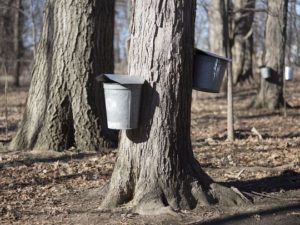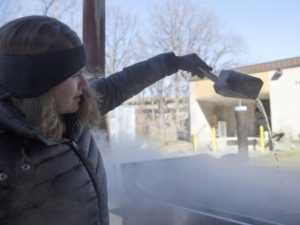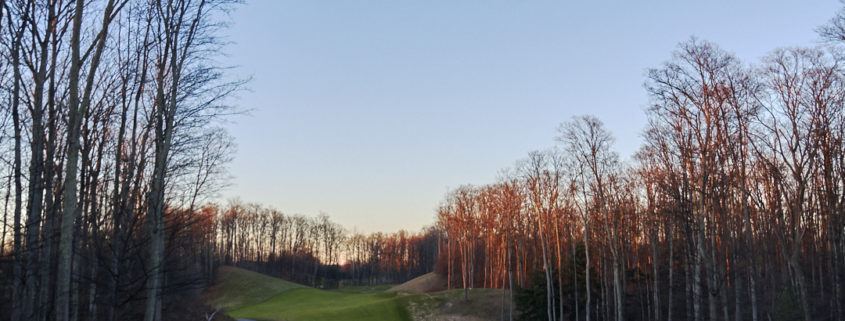Pancakes and Spring Golf connected?
The trees are sprouting buckets signaling maple syrup season is upon us, normally followed by spring golf. With unseasonably warm weather thawing out the Traverse City area could we be in for an early season at the course? Time will tell… while you’re waiting for us to open here’s a great read on how the weather affects more than we realize
MASON, Mich. — Bryan Droscha spent a recent afternoon in the woods, running sap lines in a newly leased parcel that will add to his family’s maple syrup operation.
With another sugaring season beginning, there was no time to waste.
Like other maple syrup producers, Droscha had to decide on the best time to tap his trees. Do it too early and you could miss the best flows if conditions are better later. Wait too long and you could miss the best sap. Once trees start budding, the quality of the sap quickly declines.
There’s even more uncertainty this year, given the unusually warm winter that threatens to shorten the season. Some producers are collecting less sap than in previous years, or having to use more to make the same amount of maple syrup.
“I’m very concerned,” Droscha said. “We’ve had a few warm days in the past, but a week-long warm-up like we had (in February) is pretty unheard of.”
 February was the second-warmest recorded in the Detroit and Flint areas, said Joseph Clark, meteorologist for the National Weather Service.
February was the second-warmest recorded in the Detroit and Flint areas, said Joseph Clark, meteorologist for the National Weather Service.
In Detroit, the average temperature for the month was 37.9 degrees, 9.8 degrees above normal. One stretch, from Feb. 18 through Feb. 24, saw some record-breaking high temperatures in the upper 60s and even 70 degrees.
Ideal weather for sap flow is when temperatures are below freezing at nighttime and above freezing in the 30s and 40s during the day. When the weather is well above freezing both day and night, the sap can run to tops of the trees.
“The sap continues to make its way to the branches of the trees where it’s going to nourish the buds,” said Rick Simek, program supervisor at the Environmental Interpretive Center at the University of Michigan-Dearborn.
“If it stays warm day and night over the course of several days to a week or so, the sap mixes with enzymes in the buds and turns bitter, and that marks the end of the maple syrup season.”
Maple syrup is a multimillion-dollar industry in Michigan. Over the past four years, the state has produced anywhere from 90,000 to 148,000 gallons a year.
The season typically lasts four to six weeks. March is usually the sweet spot. This year, some producers in southern Michigan tapped as early as late January.
Steve Henson, vice chair of the Commercial Maple Syrup Producers of Michigan, tapped his trees at Doodles Sugarbush in Blanchard about a week and a half ago. He said he decided to wait out February’s warm-up because bacteria can thrive in warmer weather.
Kirk Hedding, president of the Michigan Maple Syrup Association, said prolonged warm weather, for a variety of reasons, can lead to a drop in sap’s sugar content. He owns H&H Sugarbush in Chelsea, where current conditions are mimicking what typically doesn’t happen until the end of the season.
“When the sugar content is low, you’re using almost twice as much energy to make the syrup,” he said. “Now it’s taking more gallons to make syrup. We pull in 2,000 gallons of sap a day, and we should get 40 to 50 gallons of syrup out of that. We’re only making 20 to 30.”
Droscha and other Lansing-area producers are hoping for a bounce-back season after a difficult 2016. Midwest producers struggled in 2016, even though the industry as a whole had a banner year.
“Last year, the trees never really went to sleep,” said Droscha, whose operation typically produces over 1,000 gallons a year.

Michigan’s fruit growers also are watching the weather with some trepidation.
Apples, peaches and other fruit crops were devastated in 2012, when a streak of summer-like temperatures with highs in the 80s in March caused the trees to bloom early. Subsequent freezing temperatures caused widespread losses.
It’s a little too early to say how fruit crops might fare this year, experts say. But there’s been no sign of weather-related crop damage.
“We’re concerned, but not really worried right now,” said Mark Longstroth, a Michigan State University Extension fruit educator.
Crops need a sufficient number of “chilling hours,” or a period in which they remain dormant, over the winter before they can begin growing in the spring.
Trees in the southern part of the state are showing signs of growth. But further north, the trees probably haven’t completed their chilling requirement and wouldn’t be harmed by a cold snap, Longstroth said.
Many farmers in southern Michigan welcomed the cooler weather late last week, when high temperatures in the Detroit area were in the upper 20s and low 30s. Longstroth said it wasn’t cold enough to hurt fruit crops, but cold enough to stop them from continuing to grow. Plants and trees are the most susceptible to cold weather damage after they begin flowering.
Meanwhile, maple syrup producers and hobbyists are wondering how much more time they’ll have in their season.
Maple syrup season typically ends in mid-April at the Keller Family Farm in Almont. But this year, Richard Keller, who handles media relations for the farm, said they’re wondering whether it will last another week.
In the first four weeks of this season, the farm collected about 1,500 gallons of sap — about 3,000 gallons less than what they get in the first four weeks of a typical season.
The Environmental Interpretive Center in Dearborn has about 50 sugar maple and black maple trees with taps.
Simek said he noticed about two weeks that the silver maple trees around the center had experienced “bud break,” which is when tree buds burst in spring. Silver maples typically have bud break a week or two before sugar maples, he said.
“Since we had this spike of warm weather so early in the season, it’s leaving us wondering” how long the season will last, he said. “I think if I could use one word, it would be uncertainty.”




Comments are closed.